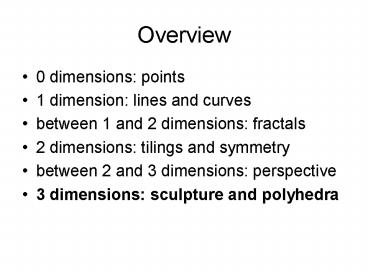Overview PowerPoint PPT Presentation
1 / 11
Title: Overview
1
Overview
- 0 dimensions points
- 1 dimension lines and curves
- between 1 and 2 dimensions fractals
- 2 dimensions tilings and symmetry
- between 2 and 3 dimensions perspective
- 3 dimensions sculpture and polyhedra
2
Polyhedra
- A polyhedron is a three-dimensional figure whose
faces (or sides) are polygons. - Examples
- pyramids
- prisms
- boxes
3
Polyhedral Art
- Another feature of Renaissance art
- Leonardo da Vincis illustrations of Paciolis
The Divine Proportion - Albrecht Durers nets and Melancholia I
- Jamnitzers plates
- Modern Artists
- The works of M. C. Escher
- The domes of architect Buckminster Fuller
4
Platonic solids
- The regular polyhedra (or Platonic solids) are
those - whose faces are identical regular polygons, and
- whose vertex configurations are the same are each
vertex - Example the cube
- We denote the vertex configuration by 4.4.4 (the
Schläfli symbol)
5
Finding the Platonic solids
- We need at least three polygons at each vertex.
(Why?) - The sum of the vertex angles must be less than
360 degrees. (Why?) - What polygons can we use (and how many of each)?
6
Constructing Platonic Solids
- Zometool pieces
- First, use blue struts only to build equilateral
triangles, squares, and regular pentagons. - Second, try putting these together to form a
Platonic solid. Fill in Exercise 7 in Section
7.2 as you do this. You should get three
Platonic solids.
7
The other two
- Use the green struts to build equilateral
triangles. - Piece these green triangles together.
- This will be trickier call me over when you
have questions. - You can see a computer representation of each
solid at this site.
8
Representing polyhedra
- Nets
- A net is a planar shape that can be folded into a
polyhedra. - Examples and nonexamples for the cube.
- Example for the tetrahedron
- Schlegel diagrams
- The picture created by suspending a light source
directly above the center of one of the faces - See this picture
- Create the Schlegel diagram for a cube
9
Eulers formula
- For each of your solids, find v e f.
- Eulers formula
- Holds for any polyhedron that is convex that
is, any line connecting any two points on faces
of the polyhedron lies inside the polyhedron. - Example show this for a right square pyramid.
10
Why does this work?
- Start with a cube and start removing faces.
- What happens to ? when you remove a face?
- What happens to ? when you remove other faces?
- A general proof
- Remove one face
- When you remove other faces (never breaking the
object into two pieces), you are in one of three
cases - The face is connected to two or more edges
- The face is connected to one edge
- The face is connected to no edges, just a vertex
- Show that the Euler characteristic doesnt change
in any of these cases. - You end up with one polygon that has ? equal to 1.
11
Exam
- Exam next Wednesday (4/16) that covers
- wallpaper classification and construction
- perspective
- polyhedra

